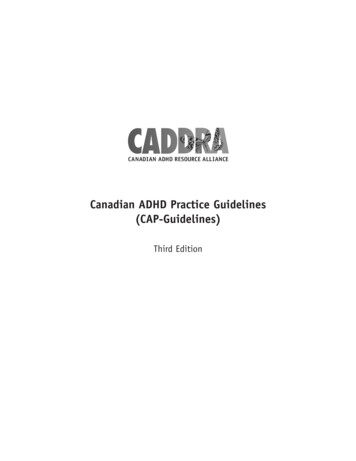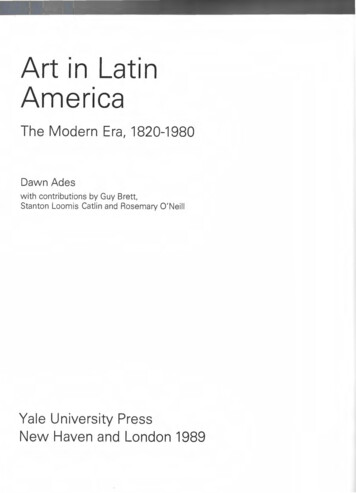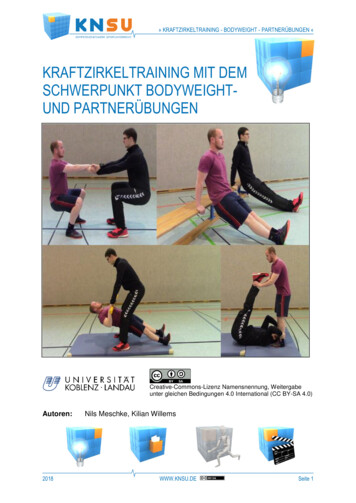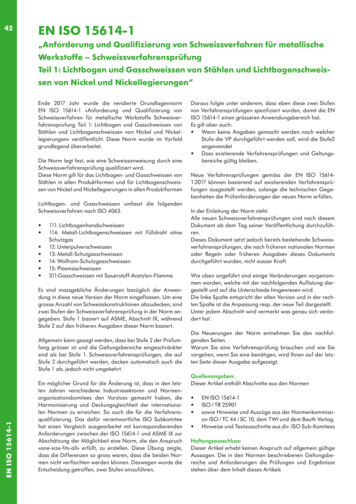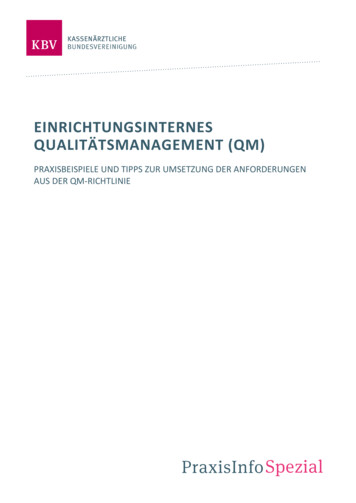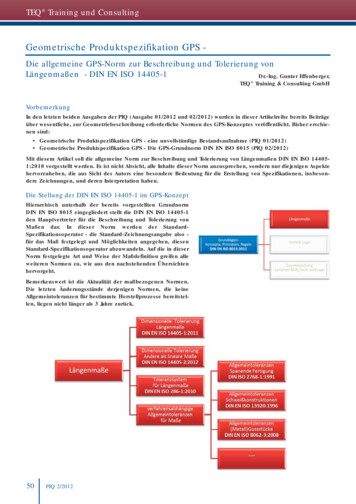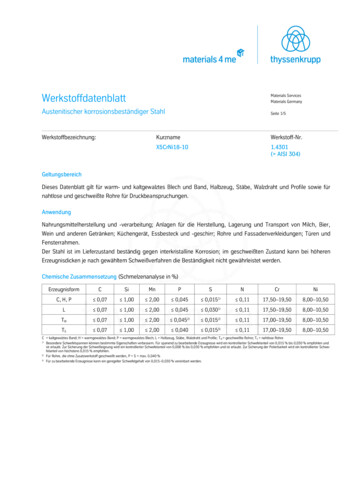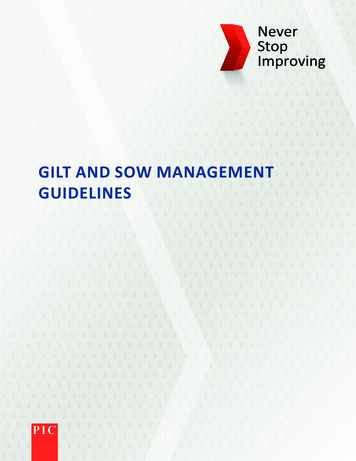
Transcription
GILT AND SOW MANAGEMENTGUIDELINES
Welcome to the 2017 Edition of thePIC Gilt and Sow Management GuidelinesWe are pleased to present the 2017 PIC Gilt and Sow Management Guidelines. These guidelines are intended toprovide recommendations for staff working at a commercial sow farm. In addition, these good management practicesare also applicable to multipliers and production nucleus farms.Compared to the 2015 edition, we have simplified the search for information. The guidelines are divided intoseven sections that cover the different phases of production on a sow farm. Each section contains expectations,good management practices and advice for troubleshooting the most common issues. In order to simplify and speedup the search for the information, we have made a serious effort to replace long texts by tables.The material has been reviewed by professionals and experts across the world to make it a global reference.The focus is on the biology of the animals, independent of the geographical location, size of operation, sow:workerratio, facilities set up or use of specific feed ingredients. The guidelines focus on production management and wehave chosen to leave out biosecurity and health protocols and acclimatization practices. We suggest you reach outto your herd veterinarian or our Health Assurance team to develop a tailored program based on your circumstances.Last, but not least, we have added separate sections for group housing and for batch farrowing.We recognize that there are different ways to achieve the desired results so these guidelines do not reject othermanagement strategies.This document is intended to provide guidance and suggestions to our valued customers. At all times, please followthe best practices and appropriate standards with respect to animal welfare and health as outlined by the localgoverning body, within your country.iPrinted 2020
Glossary of Terms & Acronyms. 1Section 1: General Farm Review. 1-1Process Review. 1-1Performance Review. 1-1Financial Impact of Key Performance Indicators.1-4Farm Visit. 1-4Section 2: Gilt Management . 2-1Eligibility for Breeding. 2-1Good Management Practices. 2-1Gilt Production Flows. 2-6Section 3: Breeding & Gestation. 3-1Good Management Practices. 3-1Post Cervical Artificial Insemination (PCAI). 3-5Pregnancy Diagnosis. 3-6Reproductive Performance Below Expectations.3-6Section 4: Group Housing. 4-1Flows and Group Size. 4-2ESF. 4-3Trouble-Shooting. 4-4Section 5: Farrowing Management. 5-1Good Management Practices. 5-1Weaning Age/Lactation Length. 5-4Trouble-Shooting Checklists. 5-4Section 6: Batch Farrowing. 6-1Type of Batches. 6-1Reconverting From Weekly Flow To Batch Farrowing.6-2Key Points. 6-3Section 7: Parity Structure. 7-1Good Management Practices. 7-2Gilt Availability. 7-2Gilt Selection. 7-2Individual Sow Care. 7-2Culling Strategy. 7-3Trouble Shooting High Sow Mortality and Low Retention Rate.7-3ii
Glossary of Terms & AcronymsSection 1PICpro100An algorithm developed by PIC to remotely screen production processes, assigning then a score from 0 to 100.ParityFemale age based on how many farrowings they have. Thus, Parity 0 is gilt that has been bred but still has not farrowed;parity 1 is a female that has farrowed once before.Parity dipIt is when litter size drops from one parity to the next. Usually from parity 1 to parity 2.TargetThe numerical value of a goal.Intervention levelThe actual performance value that should trigger defined actions to break a performance trend and improve.Breed backPercentage of the weaned females that shows standing heat within a given period, usually 7 days.Piglet conversionPercentage of weaned pigs out of the total number of pigs born in a given period.Pigs weaned/sow/yearNumber of weaned pigs in a full year divided by the average inventory of mated females.Average age at removalAge of the sows, in number of parities, when the removal (death loss and culling) happens.Section 2Eligibility for breedingA set of characteristics that make a group of gilts ready to be bred with no negative long term repercussions andoptimized economics.First breedingThe first insemination that a female gets in its life.Lifetime performanceAverage number of weaned (or marketed) pigs until the female is culled or dead.NurseryUsually the phase from weaning to 11 weeks of age.GrowerUsually the phase from 11 weeks of age to 22 weeks of age.GDUIt stands for gilt developer unit. It is usually the phase from 22 weeks of age to 28 to 30 weeks of age.cfmIt stands for cubic feet per minute. It is an expression of the volume of air moving through a ventilation systemor other space.Sq. ft.It stands for square foot, a non-metric unit of area, equivalent to 144 square inches.Breeding interval lengthTime elapsed from the moment the first female is bred until the moment when the last one is bred in the day.AI/AOIt stands for all in-all out. It refers to the way a room or an entire building is loaded and emptied.1Printed 2020
Section 3Meishan crossesAny individual containing blood from Meishan genotypes. They are broadly utilized as heat detection boars.FosteringAction to relocate individual piglets to another sow to give them more chances to nurse.Section 4Pre-implantationFlow where sows are moved to groups in early gestation, usually within 4 days after breeding.Post-implantationFlow where sows are usually moved to groups after spending the first 4 weeks of gestation in individual spaces.StaticThe group is constituted at once, social hierarchy stabilizes and the group is left intact for the duration of gestation.DynamicThe group is constantly changing by 15 to 20% of the individuals. Essentially it is a continuous flow system that looks tooptimize space utilization.Catabolic periodA time where body weight is lost, due to lack of enough feed intake or diets that don’t meet the required nutrientspecifications for the age/weight/physiological status.Section 5ft.It stands for feet, a non-metric unit of length.Split-suckleA practice to separate part of the litter for a defined period, to allow the remaining piglets full access to the udder,with no competition.Runt littersLitters created by placing small but viable piglets on a good nursing sow.Parity structureThe combination of the different ages of the sow census.PWMIt stands for preweaning mortalityRuntSmall but viable pigletSection 6Late weanersSows that don’t show signs of estrus 7 days after weaning and beyond.Non-productive daysDays where the sow is either not gestating nor lactating.2
Section 1:General Farm ReviewThis section provides checklists on key performance indicators related togeneral sow farm processes and performance. Comparing actual values versustarget levels will help sow farm managers identify improvement opportunitiesto get the most value out of their operations. It will also indicate the needfor intervention.Process ReviewIt is essential to understand the processes that could potentially limit the expression of the genetic potential. PIC hasdeveloped the PICpro100 tool to objectively assess a producer’s production practices. PICpro100 uses an algorithmdeveloped by PIC that assign a score to 23 production practices most associated with high sow herd performanceby comparing them against accepted good management practices. PICpro100 can be used to complement moretraditional methods to review and evaluate sow herd performance. The PIC Technical Services Team or yourPIC Account Manager can help you gain additional exposure to this tool.Performance ReviewIn addition to reviewing production processes, it is important to review performance records by parity and overa period of minimum 13 weeks. Key indicators to watch are farrowing rate, litter size, pre-weaning mortality,sow mortality, breeds per week and how many weeks are off target, replacement rate, wean to service interval,presence of parity dip and number of doses per sow in estrus. Many other indicators can be reviewed but the firstscreening will suggest which indicators to review and/or what to watch for during a farm visit.1-1Printed 2020
Table 1.1: Gilt Management Program TargetsKey Performance IndicatorMortality 3 to 25 weeks of ageSelection at 25 weeks of agePercentage of gilts bred at/after 2nd estrusRecorded estrus on week 4 after beginning of boarexposure at 24-26 weeks of ageParity 1 farrowing rateParity 1 litter sizeParity 1 breed backParity 1 wean to service intervalRetention rates (starting with 100 bred gilts)Target 3%70 to 80% 95%Intervention Level 5% 65% and 90% 90% 70% 50% 93% 15.5 total born 14.5 born alive 13.5 pigs weaned 90% 6 days 95 parity 1 85 parity 2 75 parity 3 90% 14.5 total born 13.5 born alive 12.5 pigs weaned 85% 7 days 85 parity 1 75 parity 2 65 parity 3Table 1.2: Entire Farm TargetsKey Performance IndicatorLactation LengthFarrowing RateLitters/Sow/YearAvg Total BornAvg Born AliveAvg WeanedPiglet ConversionBreed-backAvg Wean to Service IntervalAnnual Sow MortalityPigs Weaned/Sow/YearPigs Weaned/Farrowing Space/YearPigs Weaned per LifetimeTarget 92% 2.50 16.0 15.0 14.0 88% 92% 5.5 days 5% 35.0 212 67Intervention Level21 days 90% 2.45 15.0 13.8 12.5 83% 88% 7.0 days 8% 30.6 185 59Target 92% 2.40 16.3 15.3 14.3 88% 93% 5.0 days 5% 34.2 167 66Intervention Level28 days 90% 2.35 15.0 13.8 12.5 83% 89% 7.0 days 8% 29.4 144 561-2
Table 1.3: Specific Reproductive TargetsKey Performance IndicatorBreeding group variation, % above or below target# of weeks off breeding target within last 13 weeksConception rateTotal return rate (includes regular, non-regular andlate returns), as % of the breedsAbort rate, as % of the breedsNot-in-pig sows, as % of the breedsVaginal discharge, as % of the breedsOther reproductive failure (including dead anddestroyed while pregnant), as % of the breedsAnnual gestation feed usage per sowFeed usage in wean to service intervalSows in ideal body condition by day 30 of gestation,as % of the groupSows in ideal body condition going to farrowing,as % of the groupTarget 5% 2 97%Intervention Level 10% 3 92% 5.0% 10% 1% 0.5% 0.5% 3% 1% 1% 1% 3%1,550-1,650 lbs 1,700 lbs and 1,500 lbs(700-750 kg)( 770 kg and 680 kg) 50 lbs ( 45 lbs in Parity 1) 35 lbs ( 30 lbs in Parity 1) 23 kg ( 20 kg in Parity 1) 16 kg ( 13.5 kg in Parity 1) 85% 80% 90% 85%Target 3.0 lbs/pig ( 1.35 kg/pig) 10% 13 lbs/pig ( 6 kg/pig) 455 lbs/sow/year( 205 kg/sow/year) 16 lbs/pig ( 7.25 kg/pig) 547 lbs/sow/year( 248 kg/sow/year)5%Intervention Level 2.5 lbs/pig ( 1.1 kg/pig) 12% 12.0 lbs/pig ( 5.5 kg/pig) 370 lbs/sow/year( 168 kg/sow/year) 14.5 lbs/pig ( 6.5 kg/pig) 426 lbs/sow/year( 193 kg/sow/year) 10%Table 1.4: Specific Farrowing TargetsKey Performance IndicatorBirth WeightPre-weaning mortalityAvg piglet weaning weightLbs (kg) weaned/Sow/Year at 21-22 days of ageAvg piglet weaning weightLbs (kg) weaned/Sow/Year at 28 days of ageNurse sows, as % of the weekly farrowingsTable 1.5: Key Indicators Associated To Parity Structure On A Commercial FarmKey Performance IndicatorAnnual replacement rateCulling rateSow mortality, death rate, euthanizedAvg herd ageAvg age at removalGilt utilization up to parity 1 (% of gilts farrowed outof arrived gilts with 20 weeks of age)Gilt utilization up to parity 2Gilt utilization up to parity 3Gilt utilization up to parity 61-3Printed 2020PIC Targets45 - 55%40 - 50% 5%, 3%, 2%Parity 3.5 Parity 5Intervention Level 40%; 60% 55% 9%, 6%, 4% Parity 3.0; Parity 4.0 Parity 4.5; Parity 6.3 95% 90% 85% 75% 55% 75% 65% 45%
Financial Impact Of Key Performance IndicatorsIn addition to reviewing the production KPIs, we encourage the review of financials associated with these targets andany proposed management changes. This will help to understand where to prioritize efforts and deploy resourceswhen attempting to address indicators that are not up to the expectations.Farm VisitThe ultimate farm review is an in-person visit. It will help to confirm or rule out what is suspected from the recordsand remote review of the processes. It is also important to check that sick animals are timely treated and to discusswith the farm manager any concern about animal well-being.Table 1.6: Signs/Symptoms To Watch When Visiting A Sow FarmKey Performance IndicatorAppetiteBody conditionResponse to stimulusSoundness and structureSkin and coverPregnancyBody temperatureHealthyConsumes all feedAble to maintain itStand upBearing weight evenly on all four legsShort and smooth hair; Pink skinAble to maintain pregnancy;Mammary gland developmentNormal: up to 101.4 F (38.5 C) in gestation;Up to 104 F (40 C) while farrowingRespiratoryNormal frequency: 13-20/minFecesUrineManure is softLong and strong urine streamDistressOff-feed, feed refusalWeight lossWon’t stand up; Apathetic or lethargicLamenessLong or rough hair;Yellow, pale, red or blue skinAbortion;No mammary gland developmentFever: 101.4 F (38.5 C) in gestation; 104 F (40 C) the day after farrowingCoughing;Abnormal respiratory frequencyScours; ConstipationShort urine; White urine1-4
Section 2:Gilt ManagementThis section provides recommendations and best practices for gilt management.It will help producers prepare gilts to have high performance in their first paritywhile priming them for high lifetime performance.Eligibility For BreedingPart of the variation in performance across systems and even within systems can be attributed to the quantity andquality of gilts at their first breeding. The conditions associated with high performance in parity 1, such as lifetimeperformance and optimized cost of production, are summarized in the tables below.Table 2.1: Gilt Eligibility RequirementsTraitBody weightAverage daily gain from birth tofirst breedingImmunity levelAgeTarget 90% of gilts bred within the 300 to 350 lbs (135 to 160 kg) range1.35 to 1.70 lbs/day (600 to 770 grams/day) and 90% of gilts breed within the range3 effective weeks from last health procedureFrom 29 weeks of age (203 days),if meeting the conditions mentioned aboveGood Management PracticesUnder all circumstances, producers should adhere to the locally applicable laws that regulate management andhousing practices, even if they differ from the recommendations presented in these guidelines.2-1Printed 2020
Table 2.2: General Housing Recommendations(For additional information please refer to the PIC Wean-to-Market Production Manual)Management FactorRoom temperatureVentilationHumidityStocking densityFlooringNurseryGrowerGDUIt depends on weaning age,flooring and use of mats;70 F66 Fto be on the safe side,(21 C)(19 C)consider room temperatureat 80 F ( 26.5 C)Minimum ventilation (cold): Minimum ventilation (cold): Minimum ventilation (cold):2-5 cfm/head;5-10 cfm/head;12 cfm/head;Mild: 15 cfm/head;Mild: 35-50 cfm/head;Mild: 60 cfm/head;Maximum ventilation:Maximum ventilation:Maximum ventilation:40 cfm/head120 cfm/head150 cfm/head65% 3.5 sq ft/head 7.5 sq ft/head 12 sq ft/head( 0.33 m2/head)( 0.70 m2/head)( 1.11 m2/head)Plastic floors only to end of nursery phase;Slatted floors: 1 inch (2.5 cm) or less opening, with straight edges;Solid floors: sloped to avoid manure and liquid build-up;Use bedding material when its use is mandatory by lawTable 2.3: General Feeding RecommendationsManagement FactorNurseryGrowerGDUClean and fresh always available;Water sources1 water source per every 10 gilts;When using fixed nipple drinkers, leveled to the height of the shoulder of the smallest gilts 0.26 gallons/min 0.36 gallons/min 0.44 gallons/minVolumetric water flow rate( 1 L/min)( 1.5 L/min)( 2 L/min)Specific for age/weight;DietsUse PIC Nutritional Manual for more informationDry feeders;Wet/dry feeders;Feeder and feeders space1 in. (2.5 cm) linear space/ present gilt2 in. (5 cm) linear space/present giltFeeding strategyFull feed; Avoid feed disruptions/feed outagesTable 2.4: Preliminary Gilt Selection Recommendations(For a detailed description of the selection process refer to the PIC Selection Manual)TraitProcessGoalThrifty, unsoundness, fallingbehind, sickness, joint issuesHooves issuesTeatsNurseryAvoid sending gilts to nursery withevident issues and/or defectsGrowerThorough selection beforetransfer to GDUAvoid sending gilts to GDU withevident issues and/or defectsDo not selectDo not selectNot a routineUsually unseen at this phaseToo soon to evaluateDo not select gilts showing clubfoot, uneven toes, long dew clawsIf counted, do not selectwith less than 14 potentiallyfunctional teats2-2
Table 2.5: Mandatory Gilt Selection Recommendations(For a detailed description of the selection process refer to the PIC Selection Manual)TraitProcessThrifty, unsoundness, falling behind, sickness,joint issue, gaunt.Hooves issuesTeatsHeatsGDULast opportunity to perform quality controlDo not selectDo not select gilts showing club foot, uneven toes, long dew clawsMust be carefully counted;Do not select with less than 14 potentially functional teatsDefine a protocol to deal with non-cyclers if that are trulygilts not showing estrusTable 2.6: Boar Exposure And Heat Detection RecommendationsTraitStarts atStrategyEstimation of time neededRatio of adult boars to gilt to be boar exposedGDU24-26 weeks of age1x daily; 7 days a week; early in the morning;Nose to nose contact, with boar inside the gilt pen or in BEAR(*),15 minutes maximum per every 20-30 gilts;Never leave this job to the end of the day120 minutes/1 person/1 boar per 2,500 sows on daily basis1 adult boar per every 100 gilts;Avoid working boars longer than 60 minutes;Replace 30-40% of the boars per year(*): BEAR stands for boar exposure area. Source: Designing effective boar stimulation systems as a critical feature of the Gilt Development Unit. E.Beltranena, J. Patterson and G. Foxcroft. Leman Pre-Conference Reproduction Workshop Effective Management of Replacement Gilts (2005)2-3Printed 2020
Table 2.7: Recommendations To Address Low Percentage Of Gilts In HeatPoints to review and interventions when finding a low percentage of gilts with reported estrusPotential CausesHot weatherLimited feed intake Low boar power Low man power Exacerbated and/orcontinuous stressHealth and healthproceduresInterventionsAnnual service of the ventilation equipments and controls;Clean up fan blades and replace broken ones on an as-needed basis;Clean feeders up to avoid moldy/spoiled feed build up;Review fresh water availability;Plan to maintain man-power during holidays and vacations;Heat detection performed in the earliest/coolest part of the working daySevere restrictions can delay the group’s beginning of estrus;Check feeder space per gilt;Quantify the real needs of gilts as on over-flow of gilts could limit their easy access tothe feed;If gilts are restricted because they are too heavy, a review of the flow is needed andperhaps early breeding is advisable;Rule out mycotoxins in feedCheck if there are enough number of mature boars to perform both boar exposureand heat detection;Avoid working the boars continuously for longer than 1 hour;Over-worked/tired and/or too heavy boars don’t do a good job;Be aware that continuous exposure to the same boar(s) can also be associated with apoor gilt responseCheck effective man-hours spent on boar exposure and heat detection;Check weekend/holidays/vacation staffing;Labor qualification and expertise;If approved by regulatory entities, pharmacological interventions can be the lastresource and diagnostic. Ask your herd veterinarian when it is advisable to considerthese as an option;Slaughter checks of the ovaries. Non-cycling ovaries are smooth structures whileactive show follicles and corpus luteum development;A P4 test can identify true vs. untrue anoestrus but it is not recommended forroutine utilization. Also ask your herd veterinarian for advise. Avoid/mitigate stressor: gilts need water, feed, and to feel no fear Negative impact of major health challenges at an early phase of gilt development; Avoid vaccinations in the last 3 weeks prior to the first breeding2-4
Table 2.8: Recommendations To Address Low Litter Size And/Or Low Farrowing Rate In GiltsPoints to review and interventions to improve reproductive resultsPotential CausesHot weatherLimited feed intakeLimited boar powerLow man powerExacerbated and/orcontinuous stressHealth proceduresInterventions Check Table 2.7 Feed restriction 15 days prior breeding can hinder litter size Check Table 2.7 Production flowBreeding interval lengthSemen quality2-5Printed 2020 Check Table 2.7;Manage animal flow when there is a lack of parity segregation in group housing settingsAvoid vaccinations in first 4 weeks of gestation;Review selection criteria and process of selection when lameness is seen in recentlybred Parity 0 animals;After stocking new farms, new and abrasive floor can create hooves and sole issues;Avoid breed animals that need individual treatments around the breeding andearly gestation;If that happens, review the reasons and address them and also consider a moreaggressive culling strategyAvoid mixing and/or any stressful management from day 3 to day 28 after breedingThe shorter the better without compromising quality of the individual services,especially during hot weatherCheck with your supplier on any event that can be associated with poor performance;Check semen storage units and temperature logs;Eliminate any doses carried back from the breeding barn to the refrigerator
Gilt Production FlowsThere is no consensus on what is the best flow to generate replacement gilts as each possibility has pros and cons anddepends on the local circumstances. Different options are shown below.Table 2.9: Most Common Gilt FlowsGilt SourceExternalContinuous flowImplementation & executionof genetic programGilt flow controlAcclimatization to sow herdGilt usage rate & performanceBiosecurity concernsTransport costsDedicated laborLabor cost efficiencyBuilding costsAbility to match diets to weightsAI/AO Advantage in cleanenvironments Advantage in challengedenvironments (allowexposure management)Internal Oversized multiplicationin smaller farms Advantage in cleanenvironments Same as sow herd Good in control PRRS/PED Hard to control/eliminatediseases HigherNoneSystem choice should not be decisive Depends on volume. Need ISO & TestingLower Key: unfavorable; less favorable; highly favorable2-6
Section 3:Breeding & GestationThis section provides recommendations to realize superior reproductiveperformance. It also provides best practices on accomplishing a precise weeklybreeding target which will help to establish a consistent pig flow downstream.Good Management PracticesProducers must follow local and national regulations at any time and place. When regulation allows, consider thefollowing recommendations.Table 3.1: Housing -1Printed 2020Recommendation65 – 68 F (18 – 20 C)Minimum ventilation (cold): 12 cfm/headMaximum ventilation: 150 cfm/head 65%
Table 3.2: Weaned Sows Management RecommendationProcessCullingMovementsGeneral strategy Feeding RecommendationIdentify and mark cull sows in farrowing and avoid housing them with weaned sowsIdentify and mark sows that will need treatment after weaning;Wean early in the morning and transfer weaned sows to the wean area on the same dayMaintain an organized wean area and identify late weaners by weekly lots;Group all late weaners together in a specific area in the breeding barn;If enough replacements are available consider culling every parity 3 and older that has notcycled after day 7 post-weaning;Provide 16 hours of photoperiod and 250 lux (never fewer than 200 lux). Empiricalexperience suggests to have 150W light sources every 5 ft (1.5 m) linear;If approved by law, pharmaceutical intervention can be used to support the productionflow in critical seasons and get sows back to estrus in case of delays (always consult yourherd veterinarian for details)Review Table 3.4Table 3.3: Recommendations To Consistently Achieve Breeding Target IntegrityComponents Weekly variations Parity structure RecommendationAvoid any disruption in your weekly gilt flow availability;Maximum 5% over/under weekly breeding target to1. keep your breeding flow consistent;2. keep your weaning flow consistent;3. minimize weaning age variationOnly breed sows that are eligible to farrow and wean healthy piglets;Do not breed lame or sick sows;If enough replacements are available to preserve the breeding target, consider cullingwhat is presented in Section 7 of these guidelines;Try to solve reproductive issues by adjusting management strategies first. If approvedby law, pharmaceutical intervention can be used to support the production flow oncritical seasons and get sows back to estrus in case of delays (consult your herdveterinarian for details)3-2
Table 3.4: General Feeding RecommendationsComponentsWater availabilityDietRecommendation Feeding strategy Body conditionassessment Body weight dynamic 3-3Printed 2020Full availability and easy access;1 water source per 10 sows and 0.5 gallons (1.9 L) flow per minute in group housingFor further information refer to the PIC Nutrient Specifications Manual 20163 Phases:1. full feed on wean to service interval;2. restricted feed based on body condition during gestation;3. bump feed in late gestation for parity 0, only if body condition is normal or thin;Group gilts and sows according to body condition assessment in group housing tofacilitate feeding management;For further information refer to the PIC Nutrient Specifications Manual 2016Goal is to have 85% of the females in an ideal body condition range by 28-35 days ofgestation and 90% going to farrowing;The use of both body condition assessment systems (caliper and visual assessment)coupled with quarterly feed usage and performance data is preferred;Ideal body condition with visual assessment means that the back, hip, and rib bonescannot be seen but can be felt when touching the sow with slight pressure;Ideal condition with caliper assessment is between 12 to 15 units range;Annualized gestation feed usage should be within 1,500 and 1,700 lbs (680 and 770 kg).An investigation is needed when the farm is above or below that range;Annual sow mortality within below 9%;Perform body condition assessment at weaning;Perform body condition assessment at 30 days, 60 days and 90 days of gestation;For individually housed facilities: two people are needed: one at the back of the sowswho assesses body condition, the other one at the front adjusts the feeding boxesaccording to the nutritionist s recommendation;For further information refer to the PIC Nutrient Specifications Manual 2016Not more than 100 lbs (45 kg) of net body weight gain at parity 0;Not more than 50 lbs (23 kg) of net body weight gain from parity 1 and onwards
Table 3.5: Semen Doses Management RecommendationsComponentStorage capacitySpace cooler – wallStorage devicesmaintenanceTemperatureStorage temperatureFluctuationDeliveriesHandlingSemen ageTransport to breedingand gestation barn RecommendationSemen storage device should be sized for weekly delivery;Storage capacity equivalent to 0.16 gallon (0.6 L) per dose;Batch farrowing systems might require more storage capacity than continuous flows;Two small storage devices instead of one big can mitigate the risk of technical failures;To improve safety, have surge protectors and battery backups in place 1 inch ( 2.5 cm) Once a year; preferable prior to summer 61 – 64 F (16 – 18 C);
Table 1.1: Gilt Management Program Targets Key Performance Indicator Target Intervention Level Mortality 3 to 25 weeks of age 3% 5% Selection at 25 weeks of age 70 to 80% 65% and 90% Percentage of gilts bred at/after 2nd estrus 95% 90% Recorded estrus on week


